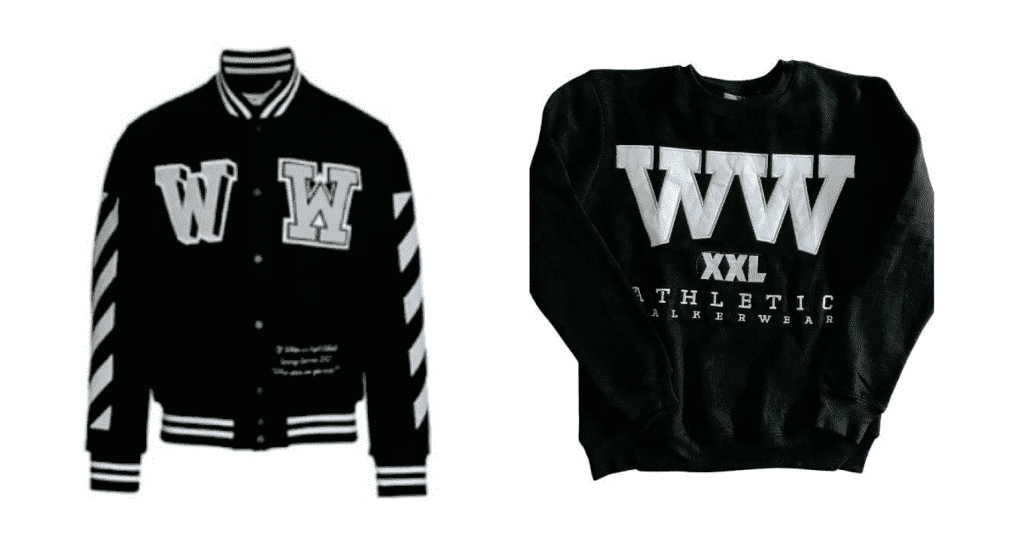Off-White has dodged a couple of claims in a lawsuit that accuses it of co-opting another fashion brand’s “unique and distinctive” trademarks and causing actual confusion among consumers, who have allegedly amistaken Off-White’s wares for those created by Plaintiff Walker Wear’s founder April Walker. In a memorandum order issued late last month, Judge Laura Taylor Swain of the U.S. District Court for the Southern District of New York sided with Off-White and agreed to dismiss the federal trademark dilution claim and one of the New York General Business Law claims that Walker Wear asserted in the trademark infringement and dilution and unfair competition lawsuit that it filed against the late Virgil Abloh’s brand, along with its stockists Saks and Farfetch, in August 2021.
Setting the stage in her August 31 order, in which she provides a neat analysis of how to make – or in this instance, fail to make – a case for trademark dilution and sheds light on the importance of the element of public harm (beyond mere infringement-related harm) in order to successfully make an unfair competition claim, Judge Swain states that Off-White and Saks have moved to dismiss two counts from Walker Wear’s amended complaint: Walker Wear’s claim for dilution under the Trademark Dilution Revision Act (“TRDA”) and its claim for deceptive acts and practices under New York General Business Law.
Making a Dilution Claim
Looking first at Walker Wear’s federal trademark dilution claim, the defendants argue – and the court agrees – that Walker Wear falls short of successfully waging a claim under the TDRA, which primarily requires that a plaintiff to establish that it has a “famous” trademark. Off-White and Saks “correctly note that the fame requirement has consistently been construed to impose a heavy burden on parties seeking to assert a dilution claim,” Judge Swain states, finding that Walker Wear does not meet that burden for the marks at issue, namely, its WW XXL Athletic word mark and corresponding design logo.
“Only trademarks that enjoy such broad renown as to at least approach (if not attain) the status of ‘household names’ may qualify as famous brands under federal law,” Judge Swain states; and dilution claims cannot be “based on niche fame, i.e., fame limited to a particular channel of trade, segment of industry or service, or geographic region.’” With this in mind, the court agreed with the defendants’ argument that Walker Wear’s marks “are not ‘household names’” (i.e., they are not “widely recognized by the general consuming public of the United States as a designation of source of the goods or services of the mark’s owner.”)
Looking at the factors that the TDRA lays out to determine whether a mark is famous for dilution purposes – (1) the duration, extent, and geographic reach of advertising and publicity of the mark, by either plaintiff or third parties; (2) the amount, volume, and geographic extent of sales of goods or services offered under the mark; (3) the extent of actual recognition of the mark; and (4) whether the mark is registered on the Principal Register or under earlier federal trademark acts; the court states that all four of the factors “militate against a finding that the marks are famous.”

Advertising/Publicity – Specifically, the court says that Walker Wear’s claims surrounding media attention fall short, as the “six media items – three films and three magazine features, in which [its] designs were featured in some way” that Walker Wear points to “are simply insufficient to plausibly support an inference that [its] marks are analogous to marks that are generally considered household names, such as those belonging to Coca-Cola, Nike, or Budweiser.” (Budweiser, Camel cigarettes, Barbie, Mattel’s Hot Wheels, Coke, and Nike are among some of the brands that courts have cited as examples of the level of “true fame” required for the TDRA to apply.)
Moreover, Walker Wear’s “failure to plead any information about [its] advertising budget and recognition of the marks by the general public renders this factor unsupportive of her claim that the marks are famous,” according to the court, which provides some insight into the level of advertising that has been deemed sufficient by noting that the SDNY previously found that a reasonable jury could find “Hot Wheels” famous because, among other things, Mattel had spent $350 million on Hot Wheels advertising since its inception. Judge Swain also notes that other “courts generally have limited famous marks to those that receive multi-million-dollar advertising budgets.”
Sales – In terms of the second factor, which centers on sales of goods bearing the trademarks at issue, the court found that Walker Wear’s claim that “[c]lothing items featuring the marks have been, and remain, [its] best-sellers” is not – on its own – “a proper factual basis for a finding of fame.”
Actual Recognition – Walker Wear similarly fails on the third factor, with its primary assertion on this front being its claim that “[b]y virtue of the unique and distinctive marks . . . the American public generally, and consumers of streetwear (a multi-billion-dollar industry), readily recognize, identify, and distinguish Walker Wear’s designs.” Unpersuaded, the court says that “this statement, and the media coverage cited by [Walker Wear], fail to support a finding of fame because they focus on recognition of either the Walker Wear brand in general or of Ms. Walker’s career as a designer” – as opposed to focusing on the specific trademarks.
Registration – Reflecting on the final TDRA factor, the court notes that Walker Wear “has not pled that the marks are federally registered,” thus, the fourth factor also weighs against a finding that the marks are famous.
Taken together, the court sides with Off-White, which argued that Walker Wear’s dilution claim should be dismissed the brand has not sufficiently pled that the marks are famous, and thus, has failed to state a claim for dilution under the TDRA.
Lack of Public Harm
Off-White also successfully argues for the dismissal of Walker Wear’s claim under Section 349 of New York’s General Business Law (“GBL”), which makes it unlawful “deceptive acts or practices in the conduct of any business, trade or commerce or in the furnishing of any service” in the state. In particular, Off-White argues that Walker Wear’s GLB claim should be tossed out, as the plaintiff has failed to plead an injury to the public interest, as required to state a claim under the statute. (To state a claim for a deceptive acts and practices violation under Section 349, a plaintiff must allege facts indicating that: “(1) the act or practice was consumer-oriented; (2) the act or practice was misleading in a material respect; and (3) the plaintiff was injured as a result.”)
At the heart of Walker Wear’s GBL claim is its assertion that Off-White’s unauthorized use of its trademarks “already has caused multiple instances of actual confusion.” This is insufficient to support a claim under Section 349, Off-White argues and the court agrees, as “this alleged injury – confusion and deception of the consuming public … is not distinct from the very harm that trademark laws generally seek to redress and thus is not over and above ordinary trademark infringement.”
Citing a previous decision from the SDNY, Judge Swain states that “claims that arise out of a trademark infringement action, and disputes between competitors where the core of the claim is harm to another business as opposed to consumers, both constitute situations which courts have found to reflect a public harm that is too insubstantial to satisfy the pleading requirements [for a claim arising under Section 349].” Against this background, she finds that Walker Wear’s “conclusory allegation” that Off-White’s “‘consumer-oriented conduct has adversely affected the public interest and has resulted in injury to consumers in New York’ is plainly insufficient to support an inference that the gravamen of [Walker Wear’s] claim is harm to the public, rather than harm to Walker Wear.”
For the foregoing reasons, the court grants Off-White and Saks’s motion to dismiss Walker Wear’s claim for dilution and its GLB claim. That does not mean that the case is over for Off-White and Saks, though, as the other claims lodged by Walker Wear, including for unfair competition and trademark infringement, as well as under GBL Section 360, remain in place for Off-White and Saks; Walker Wear and Farfetch alerted the court in December 2021 that they had reached a settlement and the claims against the retailer were subsequently dismissed.
Judge Swain referred the case to the magistrate judge for general pretrial management.
UPDATED (Dec. 2, 2022): The lawsuit that Off-White waged against Walker Wear has been settled. In an order of dismissal on Dec. 2, the court states that “attorneys for the parties have advised the Court that this action has been or will be settled. Accordingly, it is hereby ORDERED that this action is dismissed with prejudice and without costs to any party, but without prejudice to restoration of the action to the calendar of the undersigned if settlement is not achieved within thirty (30) days of the date of this Order.”
The case is Walker Wear LLC v. Off-White LLC, et. al., 1:21-cv-07073 (SDNY).











